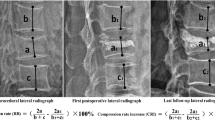Abstract
Percutaneous vertebroplasty (PVP) is an efficient procedure to treat pain due to osteoporotic vertebral compression fractures (OVCFs). However, some patient populations experience recurrent vertebral fracture after initial successful procedure. There are a lot of literatures about the effectiveness of this procedure but few concerning the development of recurrent, new compression fracture. This is a retrospective review of all PVPs performed in author’s institution from September 1999 to December 2001 to investigate the factors related to the development of new symptomatic OVCFs after PVPs. A retrospective review of 244 cases of PVP for symptomatic OVCFs at 382 levels was performed. Sociodemographic, clinical, radiologic, and procedural data were analyzed and compared between the two patient groups (control group : no further symptomatic OVCFs after the initial PVP, “new symptomatic fracture” group: with newly developed symptomatic OVCF). Statistical analysis was performed between the variables of the two groups. Survival analysis was performed using the Kaplan–Meier method. Over all, 38 among 244 treated patients (15.6%) had experienced newly developed symptomatic OVCF(s) during the follow up period (mean 52.5 months). Old age and the presence of multiple treated vertebrae at the initial PVP were assessed as a strong parameter for predicting new symptomatic OVCF. With increasing preoperative wedging deformity the risk of developing new symptomatic OVCF decreased. The Kaplan-Meier estimate of the 1 year fracture-free rate was 92.2%. The Kaplan–Meier curve showed that 7.8% of the patients would experience new symptomatic OVCF within 1 year after initial PVP. A preoperative only mild wedge deformity of the fractured vertebra(e) could indicate the increased risk of developing new symptomatic OVCF after vertebroplasty.



Similar content being viewed by others
References
Amar AP, Larsen DW, Esnaashari N, Albuquerque FC, Lavine SD, Teitelbaum GP (2001) Percutaneous transpedicular polymethylmethacrylate vertebroplasty for the treatment of spinal compression fractures. Neurosurgery 49:1105–1114
Berlemann U, Ferguson SJ, Nolte LP, Heini PF (2002) Adjacent vertebral failure after vertebroplasty. A biomechanical investigation. J Bone Joint Surg Br 84:748–752
Cohen JE, Lylyk P, Ceratto R, Kaplan L, Umanskyt F, Gomori JM (2004) Percutaneous vertebroplasty: technique and results in 192 procedures. Neurol Res 26:41–49
Deramond H, Depriester C, Galibert P, Le GD (1998) Percutaneous vertebroplasty with polymethylmethacrylate.Technique, indications, and results. Radiol Clin North Am 36:533–546
Diamond TH, Champion B, Clark WA (2003) Management of acute osteoporotic vertebral fractures: a nonrandomized trial comparing percutaneous vertebroplasty with conservative therapy. Am J Med 114:257–265
Fourney DR, Schomer DF, Nader R, Chlan-Fourney J, Suki D, Ahrar K, Rhines LD, Gokaslan ZL (2003) Percutaneous vertebroplasty and kyphoplasty for painful vertebral body fractures in cancer patients. J Neurosurg 98:21–30
Garfin SR, Yuan HA, Reiley MA (2001) New technologies in spine: kyphoplasty and vertebroplasty for the treatment of painful osteoporotic compression fractures. Spine 26:1511–1515
Grados F, Depriester C, Cayrolle G, Hardy N, Deramond H, Fardellone P (2000) Long-term observations of vertebral osteoporotic fractures treated by percutaneous vertebroplasty. Rheumatology (Oxford) 39:1410–1414
Guglielmi G, Andreula C, Muto M, Gilula LA (2005) Percutaneous vertebroplasty: indications, contraindications, technique, and complications. Acta Radiol 46:256–268
Hardouin P, Grados F, Cotten A, Cortet B (2001) Should percutaneous vertebroplasty be used to treat osteoporotic fractures? An update. Joint Bone Spine 68:216–221
Heini PF, Berlemann U (2001) Bone substitutes in vertebroplasty. Eur Spine J 10 Suppl 2:S205–S213
Kim SH, Kang HS, Choi JA, Ahn JM (2004) Risk factors of new compression fractures in adjacent vertebrae after percutaneous vertebroplasty. Acta Radiol 45:440–445
Kremer MA, Fruin A, Larson TC III, Roll J, Weil RJ (2003) Vertebroplasty in focal Paget disease of the spine. Case report. J Neurosurg 99:110–113
Legroux-Gerot I, Lormeau C, Boutry N, Cotten A, Duquesnoy B, Cortet B (2004) Long-term follow-up of vertebral osteoporotic fractures treated by percutaneous vertebroplasty. Clin Rheumatol 23:310–317
Lindsay R, Silverman SL, Cooper C, Hanley DA, Barton I, Broy SB, Licata A, Benhamou L, Geusens P, Flowers K, Stracke H, Seeman E (2001) Risk of new vertebral fracture in the year following a fracture. JAMA 285:320–323
Mehbod A, Aunoble S, Le Huec JC (2003) Vertebroplasty for osteoporotic spine fracture: prevention and treatment. Eur Spine J 12 Suppl 2:S155–S162
Moreland DB, Landi MK, Grand W (2001) Vertebroplasty: techniques to avoid complications. Spine J 1:66–71
Nakano M, Hirano N, Ishihara H, Kawaguchi Y, Matsuura K (2005) Calcium phosphate cement leakage after percutaneous vertebroplasty for osteoporotic vertebral fractures: risk factor analysis for cement leakage. J Neurosurg Spine 2:27–33
Nakano M, Hirano N, Matsuura K, Watanabe H, Kitagawa H, Ishihara H, Kawaguchi Y (2002) Percutaneous transpedicular vertebroplasty with calcium phosphate cement in the treatment of osteoporotic vertebral compression and burst fractures. J Neurosurg 97:287–293
Peh WC, Gilula LA, Peck DD (2002) Percutaneous vertebroplasty for severe osteoporotic vertebral body compression fractures. Radiology 223:121–126
Teng MM, Wei CJ, Wei LC, Luo CB, Lirng JF, Chang FC, Liu CL, Chang CY (2003) Kyphosis correction and height restoration effects of percutaneous vertebroplasty. AJNR Am J Neuroradiol 24:1893–1900
Truumees E, Hilibrand A, Vaccaro AR (2004) Percutaneous vertebral augmentation. Spine J 4:218–229
Uppin AA, Hirsch JA, Centenera LV, Pfiefer BA, Pazianos AG, Choi IS (2003) Occurrence of new vertebral body fracture after percutaneous vertebroplasty in patients with osteoporosis. Radiology 226:119–124
Wilson DR, Myers ER, Mathis JM, Scribner RM, Conta JA, Reiley MA, Talmadge KD, Hayes WC (2000) Effect of augmentation on the mechanics of vertebral wedge fractures. Spine 25:158–165
Winking M, Stahl JP, Oertel M, Schnettler R, Boker DK (2004) Treatment of pain from osteoporotic vertebral collapse by percutaneous PMMA vertebroplasty. Acta Neurochir (Wien) 146:469–476
Yamada K, Matsumoto Y, Kita M, Yamamoto K, Kobayashi T, Takanaka T (2004) Long-term pain relief effects in four patients undergoing percutaneous vertebroplasty for metastatic vertebral tumor. J Anesth 18:292–295
Author information
Authors and Affiliations
Corresponding author
Rights and permissions
About this article
Cite this article
Lee, W.S., Sung, K.H., Jeong, H.T. et al. Risk factors of developing new symptomatic vertebral compression fractures after percutaneous vertebroplasty in osteoporotic patients. Eur Spine J 15, 1777–1783 (2006). https://doi.org/10.1007/s00586-006-0151-7
Received:
Revised:
Accepted:
Published:
Issue Date:
DOI: https://doi.org/10.1007/s00586-006-0151-7




